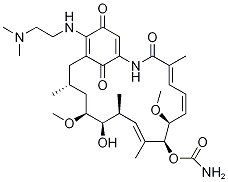Description
Geldanamycin is a potent inhibitor of Hsp90 that has poor water solubility. 17-
DMAG is a water-
soluble derivative of geldanamycin which potently inhibits Hsp90 (IC
50 = 24 nM) and has excellent bioavailability and tissue distribution in animals. Like other Hsp90 inhibitors, 17-
DMAG has diverse anti-
tumor actions and has potential in treating certain types of cancer. This compound also suppresses inflammation by interfering with signaling through the NF-
κB pathway. 17-
DMAG also ameliorates high fat diet-
induced renal failure in a mouse model of diabetes.
Chemical Properties
Solid
Uses
17-DMAG is a synthetic Geldanamycin derivative and inhibitor of Hsp90.
Uses
The labelled derivative of the analogue of Gelamycin (G304500) and 17-(Allylamino)geldanamycin (A549650). It acts as a Hsp90 inhibitor and displays more potent antitumor activity than 17-AAG.
Uses
17-DMAG is an analogue of Gelamycin (G304500) and 17-(Allylamino)geldanamycin (A549650). 17-DMAG acts as a Hsp90 inhibitor and displays more potent antitumor activity than 17-AAG.
Definition
ChEBI: A 19-membered macrocyle that is geldanamycin in which the methoxy group attached to the benzoquinone moiety has been replaced by a 2-(N,N-dimethylamino)ethylamino group.
Biological Activity
Water-soluble analog of 17-AAG (17-Demethoxy-17-(2-propenylamino)geldanamycin ) and geldanamycin (9,13-Dihydroxy-8,14,19-trimethoxy-4,10,12,16-tetramethyl-2-azabicyclo[16.3.1]docosa-4,6,10,18,21-pentaene-3,20,22-trione, 9-carbamate ). Binds the ATP binding site of Hsp90 and inhibits its chaperone activity. Displays more potent antitumor activity than 17-AAG (mean GI 50 values are 53 and 123 nM for 17-DMAG and 17-AAG respectively).




